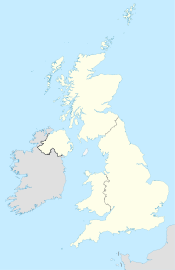- Moel-y-Parc transmitting station
-
Moel-y-Parc Height of mast 235 metres (771 ft) Grid reference SJ123702 Built 1963 BBC region BBC Wales ITV region ITV Wales, ITV Granada The Moel-y-Parc transmitting station is situated on Moel y Parc, a hill in north-east Wales at the northern end of the Clwydian range, close to the town of Caerwys and several kilometres north-east of Denbigh. It has been on the air since 1963 and is currently administered by Arqiva. It is the tallest structure in North Wales.
The mast is 235 metres (771 ft) high, and its overall height above sea level is approximately 575 metres (1,886 ft). Its official coverage area includes parts of Flintshire, Denbighshire and Wrexham (although the majority of Wrexham is in a blindspot of direct transmission from Moel-y-Parc, its analogue transmissions are relayed via the Wrexham-Rhos Relay). A network of relay stations extends television coverage as far as Colwyn Bay in the west and Bala in the south.
It reverted to a B group transmitter at digital switchover (DSO).
Contents
Channels listed by frequency
Digital radio (DAB)
Frequency Block kW[1] Operator 222.064 MHz 11D 9.5 Digital One 225.648 MHz 12B 10 BBC National DAB 227.360 MHz 12C 5 MXR North West Digital television
As part of the digital switchover, analogue BBC Two Wales ceased transmission on 28 October 2009, followed by analogue BBC One Wales, ITV1 Wales and S4C on 25 November 2009. They were replaced by higher powered digital transmissions.
Frequency UHF kW[2] Operator 642.0 MHz 42 20 BBC B 666.0 MHz 45 20 BBC A 689.8 MHz 48- 10 Arqiva B 698.2 MHz 49+ 20 Digital 3&4 713.8 MHz 51- 10 SDN 722.2 MHz 52+ 10 Arqiva A Reception area
In terms of land area and population, Moel-y-Parc delivers a receivable signal to a greater area, and a greater number of potential viewers, in North West England than in its intended coverage area of north-east Wales. Transmissions can be received using standard aerials in Liverpool, parts of Manchester, parts of Lancashire as far north as Blackpool, and Wales-facing coastal areas of Cumbria and the Isle of Man. In the past, some English viewers have erected a second aerial for Moel-y-Parc in order to receive a slightly increased choice of viewing, although this practice has declined with the introduction of satellite television and the reduction in schedule variations between different ITV regions. Liverpool is located directly between the Winter Hill transmitter and Moel-y-Parc, and many Liverpudlians obtain a watch-able picture through the back of their normal TV aerial.
The Welsh stations transmitted from Moel-y-Parc compete with English TV stations transmitted from the Winter Hill, which can be received in the Wrexham area and along the North Wales coast.
Prior to 1963, the only official ITV provider for north-east Wales was Granada Television based in Manchester. Pressure for a distinctly Welsh TV station was one of the driving forces behind the construction of the Moel-y-Parc mast, along with the need to deliver television to the more mountainous interior of Wales, which was out of range of English transmitters. As late as the 1980s, Granada continued to claim north Wales as part of its coverage area. After a series of mergers, Granada and HTV Wales are now both part of ITV plc, and competition between the two providers is undoubtedly more muted, however both Granada and HTV still provide local news and programmes for those in North Wales. The ITV Regions Official Map distinctly shows the area of North Wales as part of Granada, however for many across North and Mid Wales, it is possible to receive Central (West) via The Wrekin Transmitter. Unlike Granada, these areas are not shown as part of Central's coverage area on the ITV Regions map, and neither are they included as part of the region in Central's weather forecasts [1].
DSO problems
Moel-y-Parc has always had co-channel interference issues with a number of other co-receivable transmitters such as Llanddona, Storeton, Fenton, Sutton Coldfield and The Wrekin B (see external links). In analogue, Greater Manchester area was also able to receive Welsh channels because the Saddleworth transmitter, a relay of Winter Hill, used the same frequencies as Moel-y-Parc.
By December 2009, more than 6,000 complaints over interference from Moel-y-Parc had been received following the changeover to digital in the Granada TV region Many residents in Wirral and west Cheshire only found Welsh channels including BBC Wales and S4C at the top of their channel listings (instead of BBC North West and Channel 4). Digital UK, the organisation responsible for the switchover, said interference had always occurred and responded by telling consumers to retune their systems manually.[3]
See also
- Wales West and North Television
- Flint TV relay - one of Moel-y-Parc's relay transmitters
- Wrexham-Rhos Relay - Moel-y-Parc's Wrexham relay
- List of tallest buildings and structures in Great Britain
References
- ^ Radio Listeners Guide 2010
- ^ Television Viewers Guide 2009
- ^ "Digital UK advises Granada TV viewers over Welsh channels problem". 2009-12-24. http://www.chesterchronicle.co.uk/chester-news/local-chester-news/2009/12/24/digital-uk-advises-granada-tv-viewers-over-welsh-channels-problem-59067-25449093/. Retrieved 2010-08-19.
External links
- The Transmission Gallery: photographs, information and coverage maps
- Pictures and info of Moel Y Parc including co-receivable transmitters
- Moel-y-Parc photo gallery at the-Moores.co.uk
- Moel-y-Parc Transmitter at thebigtower.com
Transmitter sites in Wales Transmitter stations Arfon · Carmel · Criggion · Ferryside · Flint · Haverfordwest · Kilvey Hill · Llanddona · Moel-y-Parc · Preseli · Wenvoe · Wrexham-Rhos
Categories:- Buildings and structures in Flintshire
- Transmitter sites in Wales
- Radio masts
Wikimedia Foundation. 2010.

